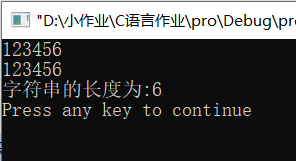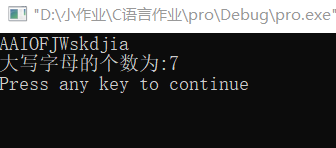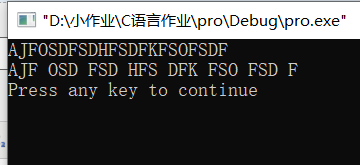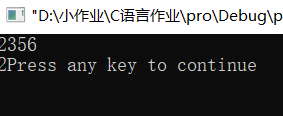第九次
1.字符串的长度.
|
1
2
3
4
5
6
7
8
9
10
11
12
|
#include<stdio.h>main(){ char str[80]; int i=0; int length=0; gets(str); puts(str); while(str[i++]!='\0') length++; printf("字符串的长度为:%d\n",length);} |

2.编写程序,统计字符串中大写字母的个数
|
1
2
3
4
5
6
7
8
9
10
11
12
13
14
15
|
#include<stdio.h>main(){ char str[20]; int i,cnt; cnt=i=0; gets(str); while(str[i]!='\0') { if(str[i]>='A'&&str[i]<='Z') cnt++; i++; } printf("大写字母的个数为:%d\n",cnt);} |

3.编写程序,去掉字符串中所有的*号.
|
1
2
3
4
5
6
7
8
9
10
11
12
13
14
15
16
17
18
19
|
#include<stdio.h>main(){ char str[20]; int i,j; i=j=0; gets(str); while(str[i]!='\0') { if(str[i]!='*') str[i++]=str[i]; i++; } i=0; while(i<j) putchar(str[i++]);} |

4.编写程序,将字符数组a中的字母复制到字符数组b中,要求每三个字符后插入一个空格.
|
1
2
3
4
5
6
7
8
9
10
11
12
13
14
15
|
#include<stdio.h>main(){ char a[20],b[20]; int i,j; gets(a); for(i=j=0;a[i]!='\0';i++) { b[j++]=a[i]; if((i+1)%3==0) b[j++]=' '; } b[j]='\0'; puts(b);} |

5.输出字符串中位置为奇数,ASSCII为偶数的字符,
|
1
2
3
4
5
6
7
8
9
10
11
12
13
|
#include<stdio.h>main(){ char str[80]; int i=0; gets(str); while(str[i]!='\0') { if((i+1)%2==1&&str[i]%2==0) putchar(str[i]); i++; }} |







 浙公网安备 33010602011771号
浙公网安备 33010602011771号